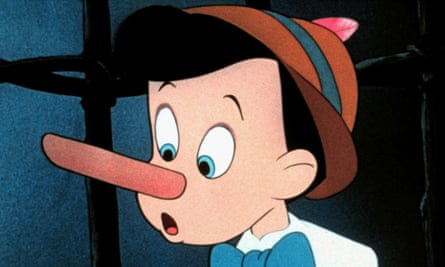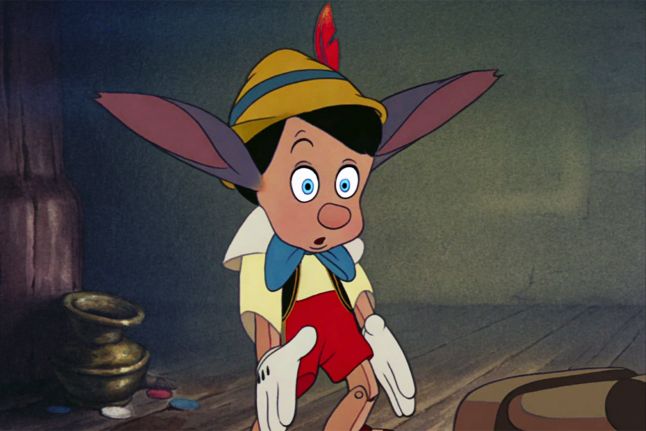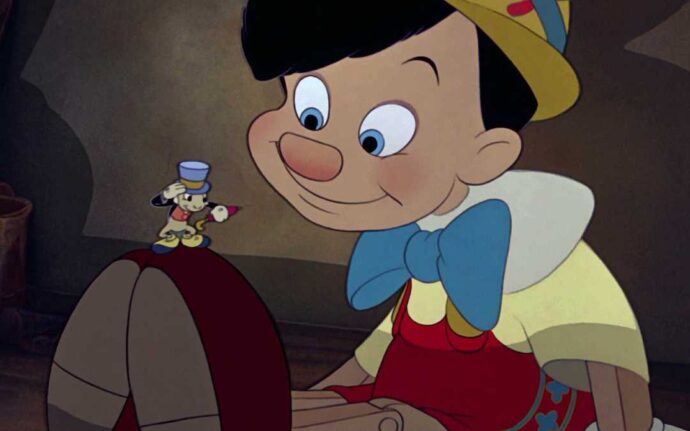Plus or Minus is a series detailing and analyzing every feature film now streaming on Disney+. It combines the unique history all these films share, their cultural impacts, and their qualities, or lack thereof. From timeless classics, to acquired hits, to DCOMs, no stone will be left unturned.
Plus or Minus continues with Walt’s grand animated follow-up Pinocchio. In a workshop in Italy lived an old woodworker named Geppetto, voiced by Christian Rub. One faithful night saw him create a marionette, a wooden boy named Pinocchio. And on that night, Geppetto wished upon a star, wishing for Pinocchio to become a real boy. And so, the Blue Fairy, voiced by Evelyn Venable, brings Pinocchio to life. However, there’s a catch. Pinocchio, voiced by Dickie Jones, can walk and talk and feel, but he’s still a wooden puppet. In order to become a real boy, he must prove to the Blue Fairy he is brave, truthful, and unselfish. Therefore, Geppetto can have his wish and a beautiful son.
And so, with the help of a cricket for a conscience, Pinocchio finds himself on a quest to prove his worth as a real boy. And along this journey, he finds himself meeting a shifty fox, a cruel puppeteer named Stromboli, an anarchic theme park, and a giant whale.
Growing from a Legacy
In the documentary The Pixar Story, Steve Jobs mentioned a business term he had coined titled “second product syndrome“. In business, it’s where an entrepreneur finds such success with their first product, they become more ambitious in their follow-up, often to the detriment of the company. And when it comes to feature animation, Pinocchio can be applied here.
The original Snow White tale was a very short story, meaning the animators had more opportunities in experimenting. However, not all the experiments work to create a coherent film. As said before, Snow White is pretty episodic, with entire sequences focusing on comedy and laughs. With Carlo Collodi’s work, there’s a much more fixed story and three-act structure, which meant the team worked on a more traditional piece. Not a bad thing, as it meant they could figure out what worked in Snow White, and applied it to their next film.
Another part of the film’s ambitions were its special effects. While effects animation was in Snow White, Pinocchio was almost entirely effects. Rain, lightning, smoke, snow, shadows, and water were all present. That’s not even mentioning the heavenly glow of the Blue Fairy. This allowed the movie to feel real and alive, improving on what Snow White did only three years ago. And it was totally worth it.
The Odd Life of Pinocchio
The most fascinating part of Pinocchio on a re-watch is how bizarre the world is. The film is very episodic, as Pinocchio finds himself meeting a new batch of characters in almost every sequence. A sly fox and mute cat named Honest John and Gideon. An Italian stereotype of a puppeteer named Stromboli. A nefarious Coachman with a twisted plan involving troublesome boys. A delinquent boy named Lampwick. A horrifying sperm whale named Monstro.

This all leads to a bizarre world that has little logic to it, yet brings so much fun and charm all the same. There’s so much creativity on display. Every sequence is memorable, and all the characters he meets are unique and riotously entertaining. In particular, the Pleasure Island sequence is fantastic. It brings such fun and riotous energy, while also having a dark undertone right off the bat. This leads up perfectly to Lampwick’s infamous donkey transformation that is still terrifying and animated perfectly.
This is only further shown in the animation. The character designs are distinct and appealing, and the backgrounds are colorful and distinct. However, as I said earlier, the effects are the star of the show, particularly in the end. The waves crashing in the ocean, the droplets emerging as Monstro leaps into the air, and even Pinocchio and Jiminy stuck underwater is so astonishing to look at. It broke new ground, allowing audiences to feel as if they were in the moment. There they were with Pinocchio, taking part in a puppet show or traveling to Pleasure Island. They got to be in the ocean, swallowed by a whale, and trying to break free.
It’s a gorgeous film that enhances the wackiness and oddities found within.
The Little Wooden Head
Of course, the star of the film is Pinocchio himself. Being naive and innocent, Disney’s team smartly portrayed the puppet as, funny enough, a real boy. He is only just discovering the world, having been born yesterday. So, he’s not some perfect child. He’s gullible, believes everything, and will try and cover his mistakes. Sure, he’s still kind and good-hearted, but there’s a mischevious side to him all the same.
However, this never results in Pinocchio being too unlikable. While his arc isn’t fully defined, there is a sense he is learning and trying to be better for himself and for his father.
Hide from it, or Learn from it
It is Pinocchio’s characterization that really allows the message of the movie to come through: the world is awful and you have to fight it. The most famous element to come from Pinocchio is the song “When You Wish Upon a Star”. It became the anthem for The Walt Disney Company, as a way to make it seem like Disney’s capitalist ventures are full of whimsy and magic.
And while not a major controversy, the song’s lyrics purport the idea that Disney is telling kids that wishing on a star makes dreams come true. Even Disney would poke holes in the supposed idea Pinocchio supported with The Princess and the Frog. However, I feel as if the film’s themes are a lot smarter than people give credit for.
The Blue Fairy asks for Pinocchio to become a real boy. Learn how to be truthful, brave, and unselfish, and then he gets his reward. Magic and wishing can only get you part of the way. Putting the work in to be a good person is necessary to get what you want. It’s a really mature message that’s handled exceptionally well.

Pinocchio’s actions have consequences. He’s put into danger because of his actions. Plus, Pinocchio goes through visual metaphors for his actions. His nose grows longer because he lies, for a lie becomes bigger and bigger until it’s plain as the nose on your face. He turns into a donkey, because he’s making a jackass of himself. Pinocchio causes problems and makes mistakes, and now he has to deal with them.
This all leads to a film that gets pretty dark at points. There’s a foreboding dread in the crooks and creeps Pinocchio encounters, which works twofold. It makes the maturity and growth of Pinocchio as a child feel earned, as well as makes the joyous and happy moments all the more special.
And once Pinocchio’s daring journey finishes, becoming a real boy in the process, it’s such a glorious moment. The struggles and the horrors were worth it, with such a beautiful ending and such a perfectly-created bow to this magnificent gift.
Plus or Minus?
Deciding whether Pinocchio was a Plus or Minus was a no brainer. I knew right from the first minute what my answer would be.
Pinocchio is a masterclass in animation and storytelling. Its creativity is unmatched and its characters are unique and a joy to watch. Its themes are subtle yet poignant and its maturity is suprisingly deft. It is so clear, looking at the Plus or Minus scale, Pinocchio is a perfect Plus and it will be hard to top this.
Next time: Swiss Family Robinson from 1940. Is a film without Walt Disney’s touch a Plus or Minus?
